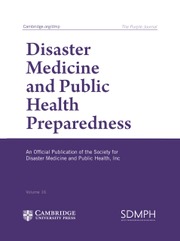No CrossRef data available.
Article contents
Prioritized Health Issues, Solutions, and Vulnerable Groups of Residents Recovering From Nuclear Disaster: A Qualitative Analysis of Interview Data
Published online by Cambridge University Press: 14 November 2025
Abstract
This study examined the health-related issues and proposed solutions among residents who returned or migrated to Namie in Fukushima Prefecture, Japan, after the evacuation order following the Fukushima Daiichi Nuclear Power Plant (FDNPP) accident was lifted. Moreover, this study assessed vulnerable groups comprising individuals who faced difficulties obtaining health services.
This study conducted semi-structured interviews with 16 participants who lived or worked in Namie. A thematic analysis was employed to analyze the interview data.
The results revealed four themes regarding prioritized health-related issues: poor lifestyle habits cause disease, mental health, inadequate medical and nursing care systems, and social isolation and issues with social relationships in the community. Likewise, four themes were identified for solutions: measures to improve lifestyle habits, enhancement of medical and nursing services, revitalization of community and social relationships, and provision of personalized care and support. Additionally, seven groups that had difficulty accessing health services were identified.
The findings suggest that comprehensive individual support is required during the long-term recovery phase after nuclear disasters to meet the health needs of vulnerable groups.
Information
- Type
- Original Research
- Information
- Copyright
- © The Author(s), 2025. Published by Cambridge University Press on behalf of Society for Disaster Medicine and Public Health, Inc

